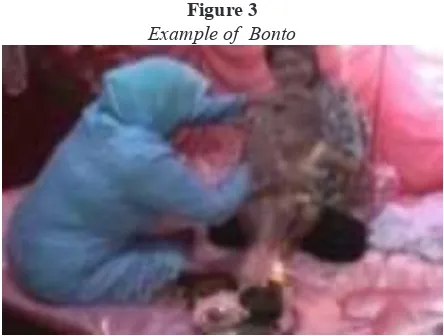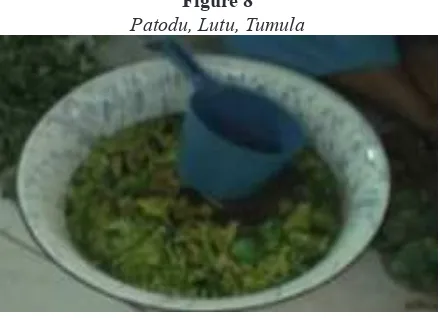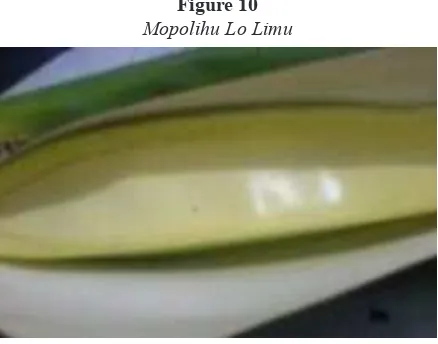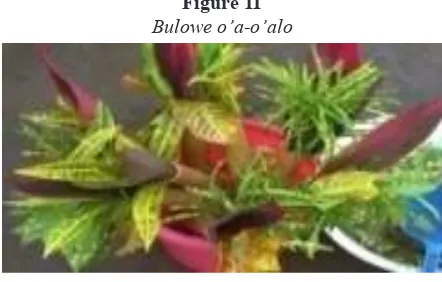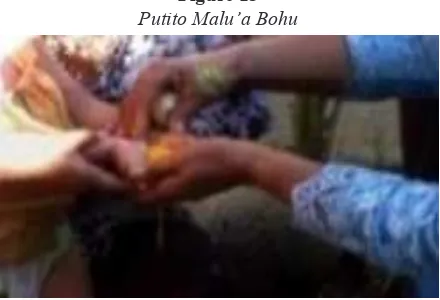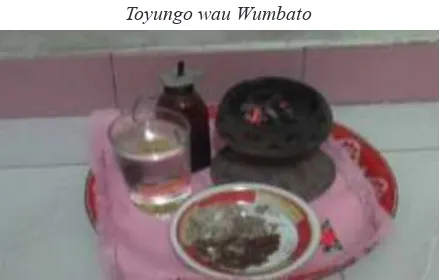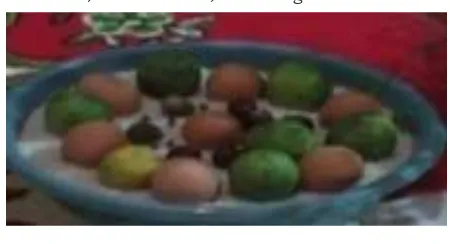Semioics and Its Applicaion
in Pohutu Aadai Lihu Lo Limu Devices in Gorontalo
Sance A. Lamusu
Gorontalo State University Email: [email protected]ABSTRACT
This article is a preliminary research on pohutu aadati lihu lo limu, ‘customary ceremonial devices of lemon bath’ which focuses on sign and sign system f language existing in the cultural device. It can be concluded that there are sign and sign system of language based on relation between expression and content (ERC) and sign system of language which is based on the relation of reality and its basic kinds such as icons, indices, and symbols ([R]-[O]-[ I]. Sign and sign system [E]-[R]-[C] have forms like [R] between E and C: that the development of meaning and change to the secondary or connotative direction [C] only once occurs in expression [E] = (E-R-C); in case the event the development of meaning and change to the secondary or connotative direction [C] occurs several times (6x) in the expression [E], the form will be like the relation of [R] E(E-R1-C; E-R2-C; E-R3-C; E-R4-C; E-R5-C; E-R6-C] C. The meaning development of such form of sign and sign system both at the level of irst-primary (denotative) and the level of second-secondary (connotative) occurs several times in [E]. It can be said that the meaning development at the level of irst-primary (denotative) is synonymous with form indices and icons and the meaning development at the level of second-secondary (connotative) is synonymous with symbols.
Keywords: sign, sign system,primary, secondary
INTRODUCTION
Gorontalo tribe is an ethnic community whose culture is actualized through their foundations of life. One of the Gorontalo tribe’s culture is Pohutu Aadati Lihu Lo Limu ‘ Lemon Bath Customary Ceremony’. Pohutu Aadati Lihu Lo Limu is a custom believed by Gorontalo tribe as Islamization and self-care for Gorontalo women starting since their childhood to adulthood. Such customary ceremony is one of the traditional aspects of birth custom which applied in every girl aged 1-3 years. Pohutu Aadati Lihu Lo Limu consists of three implementation stages and each implementation stage has cultural device as a complement to perfection or validity of the ceremony. The irst stage is mongubingo or mongulu’o ‘female circumcision’. The second stage is mopolihu lo
limu ‘bathing with fragrant water or lemon water’. The third stage is mopohuta’a to pingge ‘setting foot on seven dishes’. The interesting problem to study is sign and sign system in the cultural device used in Pohutu Aadati Lihu Lo Limu.
relation is mediated by an interpretant. According to Peirce (via Hawkes, 1978: 132), every sign certainly has two levels, namely linguistic level and mythical level. Linguistic level is a full primary signiier because the signiier has ixed meaning reference. Word or language is a signiier that refers to the denotative meaning of the signiied. In contrast, secondary signiier (at the mythical level) is a full sign at the linguistic level poured into an empty signiier. The following the example of Peirce’s classiication.
Interpretant Object
Peirce’s TriadicScheme
An interpreter is someone whose position is as a researcher, an analyst and a reviewer of an object comprehended through three lines of logic, namely the relation between logic and the signiier type (qualisign, sinsign, legisign), the relation between reality and its basic type (icon, index and symbol), and the relation between mind and the signiied type of (rheme or seme,dicent or dicisign or pheme,argument) (via E. Innis, 1985: 7-9; Santosa, 1993: 10-11). Man in his life sees a sign through two axes, namely the syntagmatic axis (juxtaposition of sign) and paradigmatic axis (associative) (Hoed, 2014: 20). The concept of syntagmatic and paradigmatic is the irst concept developed by Barthes (2007: 82) and the second concept is denotation and connotation.
Based on the aforementioned explanation, this research on the device of Pohutu Aadati Lihu Lo Limu which focuses on sign and sign system is analyzed in accordance with convention and structure of Gorontalo society. Data supporting this research are data obtained from the ield through three stages, namely informants interviewed and social situation observed in relation to the focus of the research, further sample selection in order to expand the description of information and to trace the possible variation of information, and to stop the further sample selection when variation of information are not found anymore. The samples of informants are taken following the procedure proposed by Spradley (1980: 15) through ive
and intensive in living together with the ield of activity serving as the information, (2) informants who were still fully engaged/active in the activity in which the researcher was interested, (3) informants who had enough time to be interviewed, (4) informants did not tend to process or prepare in advance in giving information, and (5) it could be determined that informants were still “unfamiliar” with the research. A method used in collecting data was snowball sampling. This method is like a rolling snowball, initially small and gradually becoming bigger and bigger (Sugiyono, 2009: 85). Data in this research were analyzed qualitatively, consisting of three simultaneous stages, namely data reduction, data presentation, and conclusion (Miles and A. Michael Huberman, 2009: 16).
THEORY OF SEMIOTICS AND
ITS APPLICATION
In the view of Saussure and Barthes, the role of semiotics in cultural studies is obvious because sign and sign system is based on conventions and rules from the society. According to Peirce, semiotics is directed more on the understanding of how human knowledge to understand things around him, both social environment and universe. On the other hand, Eco states that sign is a cultural unit in the form of symbol consisting of various types, including index and icon that represent symbol. Eco admits that the sign production is a physical activity, and the sign signiies something important. According to Culler (via Pradopo, 1995: 44), an important and meaningful sign takes the form of icon, index, and symbol. The signs have meaning based on system, rule, or convention.
or the image of view because not all chess pieces of “knight” have the same size or made of the same material, but have the same features and the same movement.
Barthes (1980: 67) uses the theory of signiiant
and signiie which is developed into a theory of metalanguage and connotation. The term signiiant becomes expression [E] and signiie becomes content or meaning [C]. However, Barthes says that there should be certain relation [R] between E and C so as to create sign [Sn]. This is a structural concept proposed by Saussure. However, the concept of relation [R] makes the theory of sign is developed further because R is determined by the user of the sign. [E] can develop and create a new sign that there is more than one signiier with the same C. This development is called metalanguage and forms what is called “synonymy”. Every sign always obtain initial meaning generally known as denotation and called primary system by Barthes and the development of secondary system towards E is called metalanguage. The secondary system toward C is called connotation, that is the development of content [C] of an expression [E]. The concept of connotation is not only based on cognitivism, but also pragmatism, i.e. the user of sign and the situation for understanding. For example, for a particular group, the lag of the United States (US) is not simply the lag of a country. In the primary system, the Relation [R] is between E (the concept of the US lag) and C (one of the symbols that represent the US), but for certain circles with their secondary system the development of C takes place, such as “the symbol of an aggressor state” or “the symbol of a terrorist state”. Therefore, R between E and C changes in the secondary system. This is a symptom of connotation that appears more clearly after the collapse of the World Trade Center Towers in New York in September 2001 and the US invasion to Afghanistan.
Semiotic theory, according to Peirce, states that all natural and cultural phenomena should be regarded as signs. He developed a sign model, namely triadic or trichotomous model, a process of understanding signs that follows the relation between the three points consisting of representamen [R], object [O], and interpretant [I]. R is part of the sign that can be perceived
physically or mentally which refers to something represented by him [O], and [I] is part of the process of interpreting the relation between R and O. Therefore, sign is not only representative, but also interpretative. For example, if someone is walking somewhere seeing smoke rising in the distance [R], the source of the smoke is (factory’s chimney) [O]. Then, it is interpreted it is already close to the car tire factory. Such interpretation is called index. If someone sees a portrait of a car, [R] refers to an [O]. In the next process, the interpretation is a green saloon car as his own car [I]. The process of such sign interpretation is called icon, that the relation between R and O indicate identity. In addition, another example, if on the beach someone sees a red lag [R], the concept of his knowledge refers to the prohibition of swimming [O]. The next interpretation is that it is dangerous to swim in that place [I], so that the sign is called symbol, that the relation between R and O is conventional, meaning that one must understand the convention regarding the relation between the “red lag” and “prohibition of swimming” (in Hoed, 2014: 57-60).
Figure 1
Pollutube, Totabu/Alama,Taluhu Ngohalati wau Tohetutu
FORMS OF SIGN AND SIGN SYSTEM
Devices in the stage of Mongubingo/Mongulu’o ‘Circumcision’
(1) Tohetutu ‘Traditional Lamp’
Figure 1 shows three objects that accompany tohetutu, namely taluhu ngohalati ‘a glass of water’, pollutube ‘a place forcinders’ and totabu/ alama ‘incense’. However, what is described in Figure 1 is only tohetutu. Tohetutu is a lamp used by the ancestors of Gorontalo [E] - [R]. If the ancestors held traditional ceremonies in the evening, tohetutu was used because it was not easily blown out by the wind although it was not as bright as electric lamp or Coleman lamp. Tohetutu is made from tree sap. Every Ramadan tohetutu is used to celebrate the culture of hui lo tumbilotohe ‘night of turning onthe light’ on the night of the 27, 28, 29 of Ramadan. This activity is one of the efforts to conserve tohetutu. Due to the dificulty of obtaining tohetutu in the present time, religious leaders, traditional leaders, and community leaders agree to replace it with oil lamps or candles in every customary ceremony. If so, the shape of the lamp is not an obligation, but the important thing here is the lighting and the strength to withstand the wind [C1]-[O1]. In this ceremony, tohetutu is interpreted as a symbol of a ray of life, even it is said that tohetutu is like edict, advice, or guide of life [C2]-[O2]. Therefore, the form of the sign [Sn] becomes E-R-C2. (E-R1-C; E-R2-C). In a further analysis, if tohetutu [R] and [O] refer to the analysis of [C1/O1] above, the process meaning that such sign interpretation is called icon because the relationship between [R] and [O] indicates identity [I]. If [O] refers to the analysis [C2/O2] above, such sign interpretation is called symbol because the relationship between [R] and [O] is conventional [I]. The conclusion from the form of sign [Sn] of tohetutu is that there is meaning at the irst -denotative (primary) level or icon, and the meaning at the second-connotative (secondary) level or symbol.
Figure 2
Alawahutilihi
(2) Alawahutilihi ‘Turmeric mixed with Slacked Lime’
Alawahutilihi is made of turmeric and slacked lime which are mashed and mixed in order to obtain a customary color of Gorontalo culture. the color in question is blood red color (see Figure 2) [E] - [R]. Alawahutilihi is made as bonto ‘mark’ on body parts of the child and his/her mother. Bonto is a confession of a servant to worship the Creator who promises to be a true Muslim [C1]-[O1]. Alawahutilihi is a symbol of pig’s blood made for Bonto [C2]-[O2]. Therefore, this form of sign is E-R-C1,2 (E-R1-C; E-R2-C). In a further analysis, if alawahutilihi [R] and [O] refer to the analysis of [C1/O1] above, such sign interpretation is s called icon because the relationship between [R] and [O] indicate identity [I]. If [O] refers to the analysis of [C2/O2] above, such sign interpretation is called symbol because the relationship between [R] and [O] is conventional [I].
Figure 3
Example of Bonto
(3) Paleyilulo ‘Colored Rice’
Paleyilulo is colored rice [E]-[R]. There are several views on paleyilulo. Paleyilulo consisting of ive colors (see Figure 4) is an offering according to the belief of Gorontalo tribe thrown to the ceiling of the house aimed at repelling evil spirits that disrupt the lives of people living in the house [C1]-[O1].
The colors of this rice are called colors of tilabataila ‘rainbow’, consisting of yellow, purple (black), red, white, and green. According to the belief of Gorontalo tribe, those colors are feared by evil spirits [C2]- [O2]. Paleyilulo colors are used by Gorontalo tribe as custom colors that have symbols as follows: yellow symbolizing authority; purple symbolizing idelity; red symbolizing courage; white symbolizing purity; and green symbolizing fertility and prosperity [C3]-[O3]. Paleyilulo colors also symbolize human body [E]. Red symbolizes red blood; white symbolizes white blood; purple (black) symbolizes human lesh and also soil; yellow symbolizes marrow that exists in the human body; green symbolizes veins that exist in the human body [C4]-[O4]. Paleyilulo is a symbol of human life because rice is a source of strength of human to live [C5] - [O5]. The form of sign becomes the relation [R] between E and C (E-R-C). Changes and development occur toward secondary or connotative in [E], so that the form of sign of paleyilulo device becomes [R] between E and (E-R1-C; E-R2-C; E-R3-C; E-R4-C; and E-R5-C) C5). If paleyilulo is [R] and [O] refers to the analysis [C1,2,3,4,5/O1,2,3,4,5] above, such
process of sign interpretation is called symbol, because the relationship between [R] and [O] is conventional [I]. It can be concluded that the form of sign [Sn] of paleyilulo does not meaning at the irst-denotative (primary) level, but at the second- connotative (secondary) level or symbol.
Figure 4
Paleyilulo
(4) Alumbu ‘White Fabric’
Alumbu is used as a protective device for hulango ‘village midwife’ and children circumcised (see Figure 5). Alumbu measures two meters [E]-[R]. Alumbu can function according to the context of use. For example, alumbu used by a wife whose husband had passed away functions as a skirt; alumbu used by the bride on the irst night functions to perpetuate the virginity of a wife [C1]-[O1].
Figure 5
Alumbu worn by the child circumcized and hulango
(5) Duunito ‘Bamboo Knife’ and Limu Tutu ‘Kafir Lime’
The ancestors of Gorontalo in mongubingo/ mongulu’o ‘circumcision’ used duunito that now has been replaced with a knife (see Figure 6) which is used during the circumcision [E1] - [R1].
Duunito bamboo skin is already dry. Duunito is a tool that is very cheap and sterile because it is not rusty and can be replaced at any time when needed [C]-[O]. Beside duunito, there is also a kafir lime (see Figure 6) [E2- [R2]. Kafir lime is used to store thing released from the genital of the child circumcised [C1]-[O1]. Kafir lime is cut half-circle and that thing is stored in it [C2]-[O2]. Kafir lime is selected because it tastes sour and is fragrant and serves as a remedy for cough and headache, also kills germs that cause disease in the human body [C3]-[O3]. The development towards the secondary or connotative does not occur in E1, so that the form of the sign becomes E-R-C. The development towards the secondary or connotative does not occur in E2, but occurs in C, so that the form of the sign in [E1-2] is [R] between E1 and C; E2 and C1,2,3 (E2-R1-C; E2-R2-C; E2-R3-C). If duuunito wau limu tutu is [R] and [O] refers to the analysis of [C/O], [C/O1,2,3], such process of sign interpretation is icon, because the relationship between [R] and [O] shows identity [I]. It can be concluded that the sign [Sn] of duuunito wau tutu limu has meaning in the irst-denotative (primary) level or icon, and does not have meaning at the second-connotative (secondary) level or symbol.
(6) Yilonta ‘Fragrant Leaves Oil’
Yilonta consist of turmeric leaves, pandan leaves, lime leaves, onumo leaves and other fragrant leaves. All the leaves are inely cut and mixed with coconut oil [E]-[R]. Yilonta is used to treat circumcision wounds and rubbed over the entire body of the child circumcised [C1]-[O1]. Yilonta makes the child’s body fragrant [C2]-[O2]. The form of yilonta sign is [R] between E and C (E-R-C1,2). The development towards the secondary or connotative does not occur in E or C. If yilonta is [R] and [O] refers to the analysis of [C/O1,2], such process of sign interpretation is called icon, because the relationship between [R] and [O] indicates identity [I]. It can be concluded that the form of yilonta sign[Sn] has meaning at the irst -denotative (primary) level or icon, and does not have meaning at the second-connotative (secondary) level or symbol.
Figure 6
Duunito/Pito wau Limu Tutu
DEVICES IN THE STAGE OF
MOPOLIHU LO
LIMU
‘LEMON BATHING’
(7) Taluhu Moonu ‘Kafir Lime Water’
‘speaking out frankly’; (3) kekengolo ‘too nimble’; (4) kureketolo ‘to speak as she pleases regardless of others’; (5) pa’ingolo ‘like to contradict what other people say’; (6) bulabololo ‘to speak aimlessly’; and (7) hutatingolo/bangganga ‘rude’ [C2]-[C2]. Taluhu Moonu is a symbol of the human spirit that is relected through innate character and attitude or action [C3]-[O3]. The form of the sign becomes [R] between E and C1,2,3 (E-R1-C; E-R2-C; E-R3-C). The development towards the secondary or connotative occurs in E-R-C. If taluhu Moonu is [R] and [O] refers to the analysis of [C/O1], such process of sign interpretation is called icon, because the relationship between [R] and [O] indicates identity. If [O] refers to the analysis of [C/ O1,2], such process of sign interpretation symbol, because the relationship between [R] and [O] is conventional [I]. It can be conclude that the form of taluhu Moonu sign [Sn] has meaning at the irst-denotative (primary) level or icon, and meaning at the second-connotative (secondary) level or symbol.
Figure 7
Taluhu Moonu
(8) Patodu ‘Sugarcane’
Patodu, philosophically, is a plant that tastes sweet [E]. Patodu grows and develops easily [C1]; the stem has joints [C2]. Patodu is used as thirst-quencher and sweetener [C3]. In the past patodu was used as a tool to forecast a child who would be an oficer or leader when he/she were adult, based on the way he/she ate patodu. If he/ she started eating patodu from the bottom, the he/ shewas not going to be a good leader, because the part he/sheate was sweet and the last part he/she ate was less sweet; if he/she ate patodu startedeating from the top, he/she would a good and trustworthy leader, had conscience and knew the prevailing legal rules or norms (see Figure 8) [C4]. The form of sign becomes [R] between E and C1,2,3,4 (E-R1-C; E-R2-C; E-R3-C; E-R4-C). The development towards the secondary or connotative occurs in E-R-C. If patodu is [R] and [O] refers to the analysis of [C/O1,2,3], such process of sign interpretation is called icon, because the relationship between [R ] and [O] indicates identity [I]. If [O] refers to the analysis of [C4], such process of sign interpretation is called symbol, because the relationship between [R] and [O] is conventional [I]. It can be concluded the form of patodu sign [Sn] has meaning in the irst-denotative (primary) level or icon, and meaning at the second-connotative (secondary) level or symbol.
Figure 8
Patodu, Lutu, Tumula
(9) Lutu lo hulonti’o ‘Gapi Banana’
occurs in E-R-C. If lutu lo hulonti’o is [R] and [O] refers to the analysis of [C/O1], such process of sign interpretation is called icon, because the relationship between [R] and [O] indicates identity [I]. If [O] refers to the analysis of [C/O2,3,4], such process of sign interpretation is called symbol, because the relationship between [R] and [O] is conventional [I]. It can be concluded that the form of lutu lo hulonti’o sign [Sn] has meaning at the irst - denotative (primary) level or icon, and meaning at the second-connotative (secondary) level or symbol.
Figure 9
Polohungo To Bunggo
(10) Tumula ‘Coconut Sprout’
Tumula [E]-[R] (see Figure 10). If planted, coconut seedling will grow into a palm tree which is very strong, not easily toppled, and long-lived [C1]-[O1]. Tumula symbolizes a strong child and will be useful for other human beings in the future [C2]-[O2]. Tumula also serves as one of the customary marriage devices that are brought together with other objects by the groom to the bride’s house. In this case, tumula symbolizes the power of love that grows from the heart of a man to a woman whom he takes as his wife. Love grows like tumula that grows into a coconut tree which is very strong, stands tall and is not easily toppled as a result of hurricanes [C3] - [O]. The form of the sign becomes [R] between E and C1,2,3 (E-R1-C; E-R2-C; E-R3-C). The development towards the secondary or connotative occurs in E-R-C. Furthermore, if tumula is [R] and [O] refers to the analysis of [C/O1], such process of sign interpretation is called icon, because the
identity [I]. If [O] refers to the analysis of [C/ O2,3], such process of sign interpretation is called symbol, because the relationship between [R] and [O] is conventional [I]. It can be concluded that the form of tumula sign [Sn] has meaning at the irst-denotative (primary) level or icon, and meaning at the second-connotative (secondary) level or symbol.
Figure 10
Mopolihu Lo Limu
(11) Polohungo To Bunggo ‘Croton plugged
in Yellow Bamboo’
Bunggo mohelupitu ‘seven piece of yellow bamboo’ each is coated with doi tala’a ngopita ‘one coin’ and covered or plugged up with polohungo ‘croton’, tabongo meela wau tabongo moputio ‘red cordyline and white cordyline’ and illed with taluhu moonu ‘kafir lime water’ (see Figure 9) [E]-[R].
have meaning at the irst-denotative (primary) level or icon, but has meaning at the second-connotative (secondary) level or symbol.
Figure 11
Bulowe o’a-o’alo
(12) Bulowe ‘Arecanut’s
lowers’
Bulowe [E]-[R]. Bulowe has fragrance property and is also useful for medicines. Bulowe o’a-o’alo ‘open arecanut’ (see Figure 11), [C1]-[O1]. Bulowe hu’uhu’umo ‘closed arecanut’ (see Figure 12). Through bulowe hu’uhu’umo, the future of circumcised child can be found out such as mate, fortune, and fate [C2]-[O2]. In a girl, it is expected that she can follow the nature of bulowe, having a true fragrance. The true fragrance in a broad sense, is the beauty of both physical and mental [C3]. The form of the sign becomes [R] between E and C1,2,3 (E-R1-C; E-R2-C; E-R3-C). The development towards the secondary or connotative occurs in E-R-C. If bulowe is [R] and [O] refers to on the analysis of [C/O1], the meaning of the sign, it is called an icon, because the relationship between the [R] and [O] show identity [I]. If [O] refers to the analysis [C / O2,3], such process of sign interpretation is called symbol, because the relationship between [R] and [O] is conventional [I]. It can be concluded that the form of bulowe sign [Sn] has meaning at the irst-denotative (primary) level or icon, and meaning at the second-connotative (secondary) level or symbol.
Figure 12
Bulowe hu’uhu’umo
(13) Putito Malua Bohu ‘New Egg’
E and C and [R] between E1 and C1,2,3,4,5,6 R-E (E-R-C)C- E (E-R1-C; E-R2-C; E-R3-C; E-R4-C; E-R5-C; E-R6-C). The development towards the secondary or connotative occurs in E-R-C; E-R-C1,2,3,4,5,6. If putito malu’a bohu is [R] and [O] refers to the analysis of [C/O] above, such process of sign interpretation is called index, because the relationship between [R] and [O] refers to the source of mato lo putito as a customary tradition [I]. If mato lo putito is [R], [O] refers to the analysis [C/O1,2,3,4,5,6], such process of sign interpretation is called symbol, because the relationship between [R] and [O] is conventional [I]. It can be concluded that the form of putito malu’a bohu sign [Sn] has meaning at the irst-denotative (primary) level or index, and meaning at the second-connotative (secondary) level or symbol.
Figure 13
Putito Malu’a Bohu
(14) Dudangata ‘Coconut Grater’ A c c o r d i n g p o p o l i l o m o n g o p a n g g o l a ‘language of the ancestor’, hiyambola dudangata o bilulo’a o ayuwa ‘even a coconut grater has place and behavior’ [E]-[R]. This expression means that dudangata has a designated spot and never move, i.e. kitchen [C1] - [O1].
Dudangata is also equated with woman because they have always to deal with the kitchen. For example, a woman carries out duties and obligations as a wife or mother of children by taking care their clothes and food. This work is always associated with the kitchen. The message conveyed by this expression is that a woman should have a deinite place and good behavior, and be useful for other human beings (see Figure 14) [C2] - [O2].
coconut because coconut without dudangata will not work, and vice versa [C3]-[O3]. Dudangata is compared with a person with knowledge, people who need such knowledge will deinitely look for him wherever he is [C4] - [O4]. Dudangata wau bongosymbolize a tool to eliminate crime and cruelty or injustice, as cutting coconut’s hair, the more the coconut is cut, the thinner it is. Similarly, it is expected that as the age increases, the child is able to stay away from despicable disposition [C5]-[O5]. The form of the sign becomes [R] between E and C1,2,3,4,5,6 (E-R1-C; E-R2-C; E-R3-C; E-R4-C; E-R5-C; E-R6-C). The development towards the secondary or connotative occurs in E-R-C; E-R-C1,2,3,4,5,6. If dudangata is [R] and [O] refers to the analysis of [C/ O1,2,3,4,5,6], such process of sign interpretation is called symbol, because the relationship between [R] and [O] is conventional [I]. It can be concluded that the form of dudangata sign [Sn] does not have meaning at the irst-denotative (primary) level or index, but has meaning at the second-connotative (secondary) level or symbol.
Figure 14
Dudangata
DEVICES IN THE STAGE OF
MOPOHUTA’A
TO PINGGE
‘STEPPING ON PLATES’
(15) Pingge mohelupitu ‘seven plate’or bad. Therefore, the seven plates are stepped, meaning that things are not good should be avoided in this life [C2]-[O2]. The form of the sign becomes [R] between E and C1,2 (E-R1-C; E-R2-C). The development towards the secondary or connotative occurs in E-R-C; E-R-C1. If pingge mohelupitu is [R] and [O] refers to the analysis of [C/O1,2], such process of sign interpretation is called symbol, because the relationship between [R] and [O] is conventional [I]. It can be concluded that the form of pingge mohelupitu sign [Sn] there does not have meaning at the irst-denotative (primary) level or index, but has meaning at the second-connotative (secondary) level or symbol.
Figure 15
Pingge Mohelupitu
(16) Pale Tiubongo wau Binte ‘Unhulled Rice and Corn’
Pale ti’ubongo wau binte ‘unhulled rice and corn’ as shown in Figure 16 and 17 [E]-[R] are daily human needs [C1] - [O1].Why these two objects are devices in Pohutu Aadati Lihu Lo Limu? It is based on the myth of the story of Prophet Adam when he was separated from Eve for forty days. When the Prophet Adam met with a stone that looked like the form of female genitalia, lust drove Adam until he pilotuhuta ‘ejaculated’ on the stone, then with the power of God a girl came out of the stone. According to the story, the girl was killed by Adam himself, because of Eve’s jealousy. The girl was named Siti Mayakini. After Siti Mayakini was killed, and died, she was immediately buried
[E1]-[R1]. According to the story, on the grave of Siti Mayakini two kinds of grass grew, one kind of grass grew into a coconut tree (see Figure 8) and another remained growing as grass but had three lowers; one lower fell to the ground and then grew into a kind of grass called paawota/huhuloa li buumbu (see Figure 18, 19); and one lower grew into pale and one lower into binte (see Figure 16, 17). The original name of Siti Mayakini was Siti Intani ‘Siti Intan’ because she was from a stone, and so that based on pale wau binte her name became intani puti ‘white diamond’ and puti iintani ‘as white as diamond’ [C1]-[O1]. Stepping on the plate containing pale wau binte is a symbol of hard work to make a living [C2]-[O2]. The form of the sign becomes [R] between E and C (E-R1-C) [R] between E1 da C1,2 (E-R1-C; E-R2-C). The development of meaning towards the secondary or connotative occurs in E-R-C; E-R- C1,2. If pale wau binte is [R] and [O] refers to the analysis of [C/O] above, such process of sign interpretation is called symbol, because the relationship between [R] and [O] is conventional [I]. If Ti Siti Mayakini is [R], [O] refers to the analysis of [C/O1,2], such process of sign interpretation is called index because the relationship between [R] and [O] is direct and causative [I]. It can be concluded that the form of pale wau binte sign [Sn] has meaning at the irst-denotative (primary) level or icon or index, and meaning at the second-connotative (secondary) level or symbol.
Figure 16
Figure 17
Binte
(17) Po’otoheto wau Paawota/Huhuloa Li Buumbu ‘Hard Grass and Elephant Grass’ Both types of grass is packed in a single plate along with the soil. Both grasses have different properties, one is hard and another is weak [E]-[R]. Paawota/huhulo’a l i buumbu is a kind of elephant grass that is weak, grows fast and productively symbolizing woman’s gentle nature but can develop descendants or childbirth [C1]-[O1]. A woman can also take hard and soft attitudes as the hardness and softness of the two types of grass. Hard in principle and soft in speaking and acting (see Figure 18-19) [C2]-[O2]. The form of the sign becomes [R] between E and C (E-R1-C; E-R2-C). The development towards the secondary or connotative occurs in E-R- C1,2. If Paawota/huhulo’a li buumbu is [R] and [O] refers to the analysis of [C/ O1,2], such process of sign interpretation is called symbol, because the relationship between [R] and [O] is conventional [I]. It can be concluded that the form of paawota/huhulo’a li buumbu sign [Sn] does not meaning at the irst-denotative (primary) level of icon or index, but has meaning at the second-connotative (secondary) level or symbol.
Figure 18
Po’otoheto
Figure 19
Paawota/Huhulo’a Li
(18) Bakohati ‘Box of Heart/Conscience’
Bakohati ‘Box of heart/conscience’ has ive angles, containing traditional cosmetics such as scrubs and powders to make body smooth, golden yellow, and there are seven pieces (see Figure 19) [E]-[R]. In terms of religious perspective, bakohati represents a box of soul.
Figure 20
Bakohati
(19) Toyungo wau wumbato ‘umbrella and cloth’ Toyungo is used the child when he steps on the plate containing materials that have been prepared and walks seven times [E]-[R]. Toyungo is symbolizes the oneness of Allah SWT. Only God can protect all living beings on earth. Protection and help are only from Allah SWT. (See Figure 23) [C]-[O]. Wumbato is a white cloth measuring two meters [E1]-[R1]. Wumbato is a symbol in implementing custom based on purity. Toyungo wau wumbato ‘umbrella and cloth’ symbolize protection and foothold [C]-[O]. The form of the sign becomes [R] between E and C (E-R-C); [R] between E1 and C (E-R2-C). The development towards the secondary or connotative occurs in E (E-R-C). If toyungo wau wumbato is [R] and [O] refers to the analysis of [C/O], such process of sign interpretation is called symbol , because the relationship between [R] and [O] is conventional [I]. It can be concluded that the form of toyungo wau wumbato sign [Sn] does not have meaning at the irst-denotative (primary) level or icon or index, but has meaning at the second-connotative (secondary) level or symbol.
Figure 21
Toyungo wau Wumbato
(20) Hulante ‘a set of materials’
One tray containing seven bowls of rice, seven eggs, seven nutmeg, seven cloves, seven limes, and seven coins each worth Rp 100.- or 10 cents is called hulante (see Figure 22) [E]- [R]. Hulante symbolizes human life both physically and spiritually. [C] - [O]. The form of the sign becomes [R] between E and C (E-R-C). The development towards the secondary or connotative occurs in E-R-C. If hulante is [R] and [O] refers to the analysis of [C/O], such process of sign interpretation is called symbol, because the relationship between [R] and [O] is conventional [I]. It can be concluded that the form of hulante sign [Sn] does not have meaning in the irst-denotative (primary) level or icon or index, but has meaning at the second-connotative (secondary) level or symbol.
Figure 22
Hulante
(21) Pollutube, Totabu/Alama, Taluhu Ngohalati ‘Place for Cinder, Incense/Benzoin, A Glass of Water’
glass of water that is put together with other devices in the tray [C2]-[O2]. The form of the sign becomes [R] between E and C1,2 (E-R1-C; E-R2-C). The development towards the secondary or connotative occurs in E-R- C1,2. If pollutube, totabu/alama, taluhu ngohalati are[R] and [O] refers to the analysis of [C/O1], such process of sign interpretation called index, because the relationship between [R] and [O] is direct and causative [I]. If [O] refers to the analysis of [C2], such process of sign interpretation called symbol, because the relationship between [R] and [O] is conventional [I]. It can be concluded that the form of pollutube, totabu/alama, taluhu ngohalati sign [Sn] has meaning at the irst-denotative (primary) level or index, and has meaning at the second-connotative (secondary) level or symbol.
Figure 23
Pollutube, Totabu/Alama, Taluhu Ngohalati wau Tohe
CONCLUSION
Based on the above explanation, sign and sign system contained in Pohutu Aadati Lihu Lo Limu device is sign and sign system based on the relationship between expression and content (E-R-C) and based on the relationship between reality and the basic types such icon, index, and symbol ([R]-[O]-[I]. In the sign and the sign system of [E]-[R]-[C] there are forms like [R] between E and C, which means the development of meaning and the change in direction towards the secondary or connotative [C] occurs only once in the expression [E] = (E-R-C). If the development of meaning and the change towards the secondary or connotative [C] occurs several times (6x) in the
expression [E], the form becomes the relation [ R] E(E-R1-C, E-R2-C, E-R3-C, E-R4-C, E-R5-C, and E-R6-C) C. Such development of meaning of sign and sign systems form occur both at the irst-primary (denotative) level and at the second -secondary (connotative) level which can repeat several times in [E]. it can be said that the development of meaning at the irst-primary (denotative) level is synonymous with the form of index and icon and the development of the meaning at the second- secondary (connotative) level is synonymous with the form of symbol or conventional form.
REFERENCES
Barthes, Roland. (1980) Elements of Semiology. New York: Hill and Wang
---. (2007) Petualangan Semiologi. Translated by Stephanus Anwar Herwinarko. Yogyakarta: Pustaka Pelajar
Eco, Umberto. (2009) Teori Semiotika.Translated by Inyiak Ridwan Muzir.Yogyakarta: Kreasi Wacana.
Hawkes, Terence. (1978) Strukturalism & Semiotics. London: The Chaucer Press
Hoed, Benny H. (2014).Semiotik & Dinamika Sosial Budaya. Jakarta: Komunitas Bambu.
Innis, Robert E. (1985) Semiotics An Introductory A n t h o l o g y. Indiana University Press. B l o o m i n g t o n .
Miles, Matthew B. & A. Michael Huberman. (2009)
Analisis Data Kualitatif Buku Sumber Tentang Metode-Metode Baru. Jakarta: UI-Press
Pradopo, Rachmat Djoko. (1998).“Semiotika: Teori, Metode dan Penerapannya” in Jurnal
Humaniora Volume11, No. 1, Januari – April 1999, pp 76 – 84.
Santosa, Puji. (1990) Ancangan Semiotika dan Pengkajian Susastra. Bandung: Angkasa Sassure, Ferdinand de. (1988)Pengantar Linguistik
Umum (translated by Rahayu S.Hidayat).
Payot,Paris

